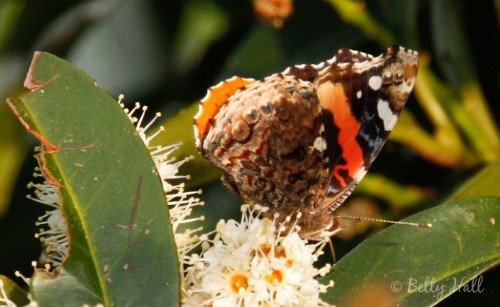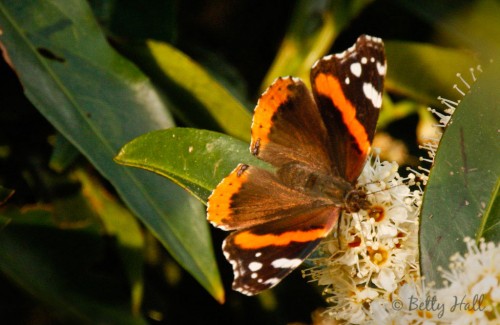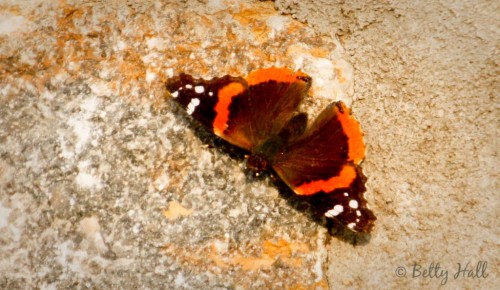I was at the Lexington Arboretum recently and saw at least fifteen Red Admiral butterflies (Vanessa atalanta) in the same area. I’ve often seen Red Admirals, but usually only one at a time.
After some reading, I’ve discovered these butterflies often migrate south in autumn and north in spring, and I’m guessing that I was seeing part of their northward migration. This one was basking in the sun on a stone column.
The Red Admiral is one of our more common butterflies and is found throughout North America, as well as Central America and parts of Europe and Asia. The distinctive bright red-orange bands on the dark-colored wings with white spots make it easy to identify when you have a top view. The side view looks quite different.
 The host plant or caterpillar food for Red Admirals is nettles. The adults feed on sap, decaying matter, and nectar. The ones I saw were feeding on the nectar of Schip Laurel (Prunus laurocerasus ‘Schipkaensis’) sometimes referred to as cherry laurels.
The host plant or caterpillar food for Red Admirals is nettles. The adults feed on sap, decaying matter, and nectar. The ones I saw were feeding on the nectar of Schip Laurel (Prunus laurocerasus ‘Schipkaensis’) sometimes referred to as cherry laurels.
 These butterflies can be seen in Kentucky from April through September. Seeing several at the Arboretum was a special treat, and I’m glad to report that I’ve now seen one in our backyard as well.
These butterflies can be seen in Kentucky from April through September. Seeing several at the Arboretum was a special treat, and I’m glad to report that I’ve now seen one in our backyard as well.
What butterflies have you seen this spring?



We’ve seen several Red Admirals this past week in our northern Kentucky yards as well. They are a beautiful little splash of color darting around the garden 🙂
Judy, glad to know you are seeing them, too.
The Red Admiral, Betty, is the most prevalent butterfly I’ve seen in my neighborhood so far this spring. In fact, I’ve already seen more around the Griffin Gate Golf Course than I saw all last summer. Leads me to speculate this will be a good year for butterfly viewing. (That’s wishful thinking talking.). Cheers, Steve.
Thanks, Steve. I saw several other butterflies at Natural Bridge this past weekend. Seems like a favorable sign.
Hi Betty, very nice info and I love the great difference between the butterflies top and side shots. Nature surely is amazing. I have seen a few pretty little white butterflies fluttering around the hillsides here in Utah but since I have no idea what they are named I’m sure that doesn’t help very much! I definitely haven’t seen any Monarchs yet (one of the few butterflies I can safely identify) but will keep a better eye out for butterflies now. The cabbage moths are surely already stalking my friends garden and for the last few weeks there have also been what I think are Miller moths madly crawling around outside my window as I stay up late on my computer. Thanks for the good info on the Red Admirals!
Keli, I expect those little white butterflies are cabbage butterflies and are the same ones that are visiting your friend’s garden. They are not native and can be quite a pest if you are trying to grow any of the vegetables in the cabbage family. Have not seen any moths but then I’m not staying up all that late either. Bet you’re surprised to hear that. ☺
Today, have about 100 in the flowering trees in our yard in northern Illinois. Beautiful.
Marie, how exciting! Can imagine it would a memorable sight to see.Thanks for letting me know.
In a 15 minute window tonight (around 7PM) while enjoying the early evening air out on my backyard deck, I counted at least 25 Red Admirals whirling and spiraling through my yard. Many of them rested and fed in my maple trees that are in bloom right now. Most danced together in pairs or quads and seemed to be enjoying the 21 degree C / 70 degree F this evening. I have lived here for 21 years and this is the first time I noticed them — in doing research, I learned they migrate the same way that the Monarchs do. That is how I found your website — hope you enjoy my observations
P.S. I am writing (and observing butterflies) from Southern Ontario, Canada. And I have a redbud tree in my front garden that is about 10 days behind the one you have pictured at the top of your website!
🙂
Sounds like a beautiful experience, Angie. I received another comment this afternoon from Marie in northern Illinois who had about 100 among their flowering trees. Must be a really good year for Red Admirals.
Glad to know where you are located and that you, too,have a redbud tree in your yard. Thanks for sharing.
.
I too am experiencing this, Angie. Your description perfectly matches our evenings lately. As many as six of these butterflies in a group of swirling dance, several groups in one backyard! We have maple and honeysuckle in abundance in our yard, so it’s good to know what may have attracted them. It’s really a sight to behold. Our children will stand in a circle on the ground below as we watch from our deck, their arms outstretched for the butterflies to land on. A wonderful childhood memory for them, I’m sure. 🙂 (We are in Kentucky).
Sounds fantastic, Emma. Another friend has described seeing a similar sight. How wonderful that you and your children could share such an experience.
We have three of these basking in the sun on our front shutters this morning and another flittering around. Very unusual for me to see several of one type of butterfly at one time in the yard, but I was thrilled!
Regina,so glad you gave me a call so I could enjoy your butterflies as well. And a special thanks for sending me the information about the thousands of red admirals in eastern and southern Ontario as well as Nova Scotia.Sounds like a most unusual happening.